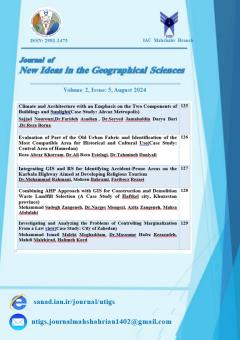تبیین اثرات مهاجرت معکوس بر توسعه کالبدی و زیست محیطی روستاهای محال انزل شهرستان اورمیه
الموضوعات : Geography and Rural Planning
شریفه جعفرمدار قرهباغ
1
![]() ,
دکتر سیمین ارمغان
2
,
دکتر سیمین ارمغان
2
![]() ,
دکتر تهمینه دانیالی
3
,
دکتر تهمینه دانیالی
3
![]()
1 - دانشجویدکتری، گروه جغرافیا وبرنامهریزی روستایی، واحد یادگارامام خمینی(ره) شهرری، دانشگاه آزاد اسلامی، تهران، ایران
2 - استادیار، گروه جغرافیا وبرنامهریزی روستایی، واحد یادگارامام خمینی(ره) شهرری، دانشگاه آزاد اسلامی، تهران، ایران
3 - استادیار، گروه جغرافیا وبرنامهریزی روستایی، واحد یادگارامام خمینی(ره) شهرری، دانشگاه آزاد اسلامی، تهران، ایران
الکلمات المفتاحية: مهاجرت معکوس, توسعه اقتصادی, توسعه کالبدی, توسعه زیست محیطی, محال انزل, شهرستان اورمیه.,
ملخص المقالة :
هدف پژوهش حاضر تبیین اثرات مهاجرت معکوس بر توسعه اقتصادی، کالبدی و زیست محیطی روستاهای محال انزل شهرستان اورمیه سال 1400-1396 بود. طرح پژوهشی، توصیفی تحلیلی بود. جامعه آماری پژوهش، 944 خانوار از شهر برگشته به روستاهای محال انزل بودند که از این تعداد، 275 خانوار با روش نمونهگیری سهمیهای انتخاب و به پرسشنامه ها به صورت تصادفی پاسخ دادند. داده¬ها با پرسشنامه، محقق ساخته که با پایایی 818/0 جمع¬آوری و با نرم افزارهای (SPSS-V.28) و (Lisrel-V.10) تجزیه و تحلیل شدند. پرسشنامه پژوهش دارای روایی تحلیل عاملی اکتشافی (847/0) و تحلیل عاملی تاییدی، مورد قبول بود. نتایج نشان داد بین مهاجرت معکوس، توسعه اقتصادی، توسعه کالبدی و توسعه زیست محیطی، رابطه مثبت و معناداری وجود دارد (P≤0.01). مهاجرت معکوس دارای تاثیر مستقیم و مثبت بر توسعه اقتصادی (69/0)، توسعه کالبدی (56/0) و توسعه زیست محیطی (55/0) بوده (P≤0.01)، و هم چنین مهاجرت معکوس دارای تاثیر غیرمستقیم و مثبت (34/0) بر توسعه کالبدی و (28/0) بر توسعه زیست محیطی از طریق توسعه اقتصادی در روستاهای محال انزل شهرستان اورمیه بود (P≤0.01). مسئولین امر باید با بررسی وضعیت روستاها، در زمینه توسعه اقتصادی روستاها تلاش کنند تا باعث بهبود وضعیت زیستی و تحکیم و به روزرسانی ساخت خانه های روستایی شده و از این طریق باعث رشد و توسعه کالبدی و زیست محیطی روستاها شوند و شرایط زندگی در روستاها جهت مهاجرت معکوس را بهبود بخشند.


